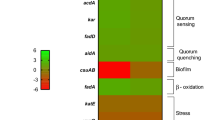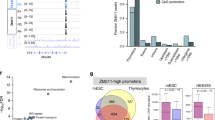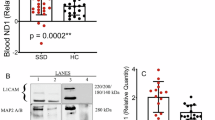Abstract
Iron-sulfur proteins participate in a wide range of biochemical processes, including many that are central to mitochondrial electron transfer and energy metabolism. Mutations in two such proteins, frataxin and ABCB7, cause Friedreich ataxia and X-linked sideroblastic anemia with ataxia, respectively, rendering other participants in this pathway functional candidates for hereditary ataxia syndromes. Recently frataxin was shown to have an identical phylogenetic distribution with two genes and was most likely specifically involved in the same sub-process in iron-sulfur cluster assembly as one gene, designated hscB, in bacteria. To set the stage for an analysis of the potential role of this candidate gene in human disease, we defined the human HscB cDNA, its genomic locus, and its pattern of expression in normal human tissues. The isolated human HscB cDNA spans 785 bp and encodes a conserved 235-amino-acid protein, including a putative mitochondrial import leader. The HscB gene is found at chromosome 22q11-12 and is composed of six exons and five introns. Northern blot analyses of RNA from adult and fetal tissues defined a pattern of expression in mitochondria-rich tissues similar to that of frataxin, an expression pattern compatible with its implied role in mitochondrial energetics and related disease phenotypes.
Similar content being viewed by others
Log in or create a free account to read this content
Gain free access to this article, as well as selected content from this journal and more on nature.com
or
References
Bekri S, Kispal G, Lange H, Fitzsimons E, Tolmie J, Lill R, Bishop DF (2000) Human ABC7 transporter: gene structure and mutation causing X-linked sideroblastic anemia with ataxia with disruption of cytosolic iron-sulfur protein maturation. Blood 96:3256–3264
Campuzano V, Montermini L, Molto MD, Pianese L, Cossee M, Cavalcanti F, Monros E, Rodius F, Duclos F, Monticelli A, et al. (1996) Friedreich's ataxia: autosomal recessive disease caused by an intronic GAA triplet repeat expansion. Science 271:1423–1427
Cavadini P, O'Neill HA, Benada O, Isaya G (2002) Assembly and iron-binding properties of human frataxin, the protein deficient in Friedreich ataxia. Hum Mol Genet 11:217–227
Cummings CJ, Zoghbi HY (2000) Trinucleotide repeats: mechanisms and pathophysiology. Annu Rev Genomics Hum Genet 1:281–328
Cupp-Vickery JR, Vickery LE (2000) Crystal structure of Hsc20, a J-type co-chaperone from Escherichia coli. J Mol Biol 304:835–845
Dhe-Paganon S, Shigeta R, Chi YI, Ristow M, Shoelson SE (2000) Crystal structure of human frataxin. J Biol Chem 275:30753–30756
Hoff KG, Silberg, JJ, Vickery LE (2000) Interaction of the iron-sulfur cluster assembly protein IscU with the Hsc66/Hsc20 molecular chaperone system in Escherichia coli. Proc Natl Acad Sci USA 97:7790–7795
Hoff KG, Ta, DT, Tapley TL, Silberg JJ, Vickery LE (2002) Hsc66 substrate specificity is directed toward a discreet region of the iron-sulfur cluster template protein IscU. J Biol Chem 277: 27353–27359
Huynen MA, Snel B, Bork P, Gibson TJ (2001) The phylogenetic distribution of frataxin indicates a role in iron-sulfur cluster protein assembly. Hum Mol Genet 10:2463–2468
Kaplan J (2002) Spinocerebellar ataxias due to mitochondrial defects. Neurochem Intl 40:553–557
Kawula TH, Lelivelt MJ (1994) Mutations in a gene encoding a new Hsp70 suppress rapid DNA inversion and bgl activation, but not proU derepression, in hns-1 mutant Escherichia coli. J Bacteriol 176:610–619
Kazemi-Esfarjani P, Benzer S (2000) Genetic suppression of polyglutamine toxicity in Drosophila. Science 287:1837–1840
Kelley WL (1998) The J-domain family and the recruitment of chaperone power. Trends Biochem Sci. 23:222–227
Kim R, Saxena S, Gordon DM, Pain D, Dancis A (2001) J-domain protein, Jac1p, of yeast mitochondria required for iron homeostasis and activity of Fe-S cluster proteins. J Biol Chem 276:17524–17532
Lutz T, Westermann B, Neupert W, Herrmann JM (2001) The mitochondrial proteins Ssq1 and Jac1 are required for the assembly of iron sulfur clusters in mitochondria. J Mol Biol 307:815–825
Matsuura T, Yamagata T, Burgess D L, Rasmussen A, Grewal R P, Watase K, Khajavi M, McCall AE, Davis CF, Zu L, et al. (2000) Large expansion of the ATTCT pentanucleotide repeat in spinocerebellar ataxia type 10. Nat Genet 26:191–194
Muhlenhoff U, Richhardt N, Ristow M, Kispal G, Lill R (2002) The yeast frataxin homolog Yfh1p plays a specific role in the maturation of cellular Fe/S proteins. Hum Mol Genet 11:2025–2036
Nishino I, Spinazzola A, Hirano M (1999) Thymidine phosphorylase gene mutations in MNGIE, a human mitochondrial disorder. Science 283:689–692
Opal P, Zoghbi HY (2002) The role of chaperones in polyglutamine disease. Trends Mol Med 8:232–236
Patel PI, Isaya G (2001) Friedreich ataxia: from GAA triplet-repeat expansion to frataxin deficiency. Am. J Hum Genet 69:15–24
Pfanner N (2000) Protein sorting: recognizing mitochondrial presequences. Curr Biol 10:R412–R415
Pfanner N, Wiedemann N (2002) Mitochondrial protein import: two membranes, three translocases. Curr Opin Cell Biol 14:400–411
Ross CA (2002) Polyglutamine pathogenesis: emergence of unifying mechanisms for Huntington's disease and related disorders. Neuron 35:819–822
Seaton BL, Vickery LE (1994) A gene encoding a DnaK/hsp70 homolog in Escherichia coli. Proc Natl Acad Sci USA. 91:2066–2070
Silberg JJ, Hoff KG, Tapley TL, Vickery LE (2001) The Fe/S assembly protein IscU behaves as a substrate for the molecular chaperone Hsc66 from Escherichia coli. J Biol Chem 276:1696–1700
Strain J, Lorenz CR, Bode J, Garland S, Smolen GA, Ta DT, Vickery LE, Culotta VC (1998) Suppression of superoxide dismutase (SOD1) deficiency in Saccharomyces cerevisiae. Identification of proteins predicted to mediate iron sulfur cluster assembly. J Biol Chem 273:31138–31144
Vickery LE, Silberg, JJ, Ta DT (1997) Hsc66 and Hsc20, a new, heat shock cognate molecular chaperone system from Escherichia coli. Protein Sci 6:1047–1056
Voisine C, Cheng YC, Ohlson M, Schilke B, Hoff K, Beinert H, Marszalek J, Craig EA (2001) Jac1, a mitochondrial J-type chaperone, is involved in the biogenesis of Fe/S clusters in Saccharomyces cerevisiae. Proc Natl Acad Sci USA 98:1483–1488
Acknowledgements
This work was supported by NIH grants MH59222 and HD035458 (to J.J.G.) and GM54264 (to L.E.V.).
Author information
Authors and Affiliations
Corresponding author
Additional information
The GenBank accession number for HscB is AY191719
Rights and permissions
About this article
Cite this article
Sun, G., Gargus, J.J., Ta, D.T. et al. Identification of a novel candidate gene in the iron-sulfur pathway implicated in ataxia-susceptibility: human gene encoding HscB, a J-type co-chaperone. J Hum Genet 48, 415–419 (2003). https://doi.org/10.1007/s10038-003-0048-9
Received:
Accepted:
Published:
Issue date:
DOI: https://doi.org/10.1007/s10038-003-0048-9
Keywords
This article is cited by
-
Arabidopsis thaliana J-class heat shock proteins: cellular stress sensors
Functional & Integrative Genomics (2009)



